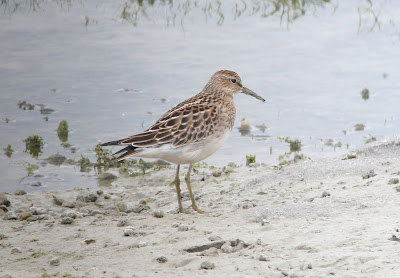FRIDAY 2 SEPTEMBER - LGRE DIARY NOTES
Today was one of those great days to be out and about. The weather was excellent and very good for diurnal migration. The winds were light - ESE early on, then southerly, then switching right round to NW by evening. Glorious sunshine throughout but then clouding over somewhat by dusk with a few spots of rain.
Laurence Drummond sent me a text early on informing me of another Common Redstart he had found. Although having had a record year for this species in Buckinghamshire, I was still missing one from my annual Hertfordshire list, so I set off in hot pursuit........
HATFIELD AERODROME (HERTFORDSHIRE)
I met up with Laurence mid-morning and he took me to where he had discovered the bird. After locating a juvenile Robin, the next bird to appear from the hedgerow was the
COMMON REDSTART - a nice juvenile male. It was favouring a fruiting Elder some 50 yards east of the former gates and showed very well for a while, flitting in and out of the hedge and occasionally on to the ground. A great start!
The hedgerow was in fact alive with migrant birds, with two different LESSER WHITETHROATS, 3 Common Whitethroats, at least 4 Blackcaps and a single SPOTTED FLYCATCHER. Just SE of the hedgerow, in weedy vegetation by the 'new' earth mound, a party of 5 juvenile
WHINCHATS were located.
As we both walked back to the cars at Notcutts, we got chatting to one of the council workers on site - responsible for maintaining and planting the trees about the recently landscaped site. At 1140 hours, I noticed a large raptor flying relatively low towards us over the fields - it was a juvenile
MARSH HARRIER. It afforded some great views as it approached but then banked and then gained height. It then worked its way slowly SSE and eventually disappeared to a dot. Minutes later it was followed by tow more raptors - this time a Red Kite and yet another juvenile MARSH HARRIER. The two tussled mid-air for a while before parting ways and the harrier also drifting off high to the SE. Incredibly, just minutes later, a third juvenile MARSH HARRIER came through with 3 juvenile Common Buzzards - all four birds eventually following the same line of movement. I can only assume that all 3 juvenile Marsh Harriers were related and were migrating as one family group (interestingly, I had witnessed a similar event at Wilstone Reservoir just over a week ago - in similar weather conditions). A couple of Eurasian Sparrowhawks were also noted.
Spurned on by such a movement of raptors, I said my goodbyes to Laurence and headed for the nearest hill escarpment........
PEGSDON HILLS/KNOCKING HOE NATURE RESERVE (BEDFORDSHIRE)
I wound up at Pegsdon Hills, where the wind had switched more to the south, and ended up walking the Icknield Way Path from Telegraph Hill to the Knocking Hoe valley. Raptor migration was in full swing but sadly consisted of just Common Buzzards - a total of 25 eventually being seen, almost exclusively fresh juveniles. One particular juvenile hanging around the Knocking Hoe valley was amazingly plumaged, having an all-white head, all white underparts and a Rough-legged Buzzard-patterned uppertail. A total of at least 6 Red Kites were also seen, as well as 2 Sparrowhawks.
Migrant passerines however were thin on the ground - particularly warblers. Three different COMMON REDSTARTS were located - a female in scrub at the extreme southern end of the main valley and a male and an immature in the small plantation lining the top of the valley along the Icknield Way. Three separate TREE PIPITS flew over south calling, whilst a solitary juvenile NORTHERN WHEATEAR was by the trig point at Deacon Hill. Just 3 Common Chiffchaffs were encountered, whilst the only other birds noted during the 1230-1500 hours stint were a pair of MARSH TITS.
At SANDY SMITH NATURE RESERVE east of Clophill, just 2 Stock Doves were seen, whilst ROOKERY PIT mid-afternoon held just a single COMMON GREENSHANK, LITTLE STINT and Little Egret. Much digging work was in progress inside the pit. Neighbouring STEWARTBY LAKE held 4 BLACK TERNS but nothing much else.
WILSTONE RESERVOIR, TRING (HERTFORDSHIRE)
Joining Steve Rodwell, Mike Hirst, Ian Williams and others at Wilstone, we did the evening shift from 1700-1930 hours. By now, the wind had veered northwesterly and cloud cover had encroached from the east. It was frustratingly quiet.
Both Dave and Roy had seen 3 juvenile CURLEW SANDPIPERS briefly early morning but none had lingered. New in this evening were a single COMMON SNIPE and another new juvenile RUFF. One juvenile RUFF from earlier lingered, along with the juvenile
LITTLE STINT on the main spit, whilst 8 RINGED PLOVERS (4 juveniles), 2 Common Sandpipers and a single COMMON GREENSHANK remained.
Otherwise, Great Crested Grebes numbered 17, Coot 386, Little Egret 19, Mute Swan 16, Common Teal 135, Shoveler 67, Northern Pochard 69 and Tufted Duck 26.
The family party of 3 HOBBIES were still in the area, whilst just 3 Common Terns remained. A single YELLOW WAGTAIL flew over, with 143 Barn Swallows in the area and at least 115 House Martins.
WORD OF CAUTION: the main road has been tarmacced today but is very slippery in places; there was one accident this evening just west of the car park
















